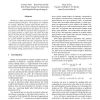Free Online Productivity Tools
i2Speak
i2Symbol
i2OCR
iTex2Img
iWeb2Print
iWeb2Shot
i2Type
iPdf2Split
iPdf2Merge
i2Bopomofo
i2Arabic
i2Style
i2Image
i2PDF
iLatex2Rtf
Sci2ools
144
click to vote
SMI
2006
IEEE
2006
IEEE
BSP Shapes
We discuss a shape representation based on a set of disconnected (planar) polygons. The polygons are computed by creating a BSP that contains approximately linear surface patches in each cell. This is achieved by employing two heuristics for finding appropriate split planes in each cell. Leaf nodes in the BSP tree represent either polygonal surface approximations or empty (clip) cells rather than split planes. We show that the resulting set of disconnected primitives typically leads to a better two-sided Hausdorff error for a given number of primitives than meshes. The BSP cells can be coded with few bits and, consequently, the tree is a compact shape representation. The special properties of BSPs are very useful in applications that need to perform spatial queries on the primitives, such as for occlusion and view frustum culling, and proximity or collision tests.
| Added | 12 Jun 2010 |
| Updated | 12 Jun 2010 |
| Type | Conference |
| Year | 2006 |
| Where | SMI |
| Authors | Carsten Stoll, Hans-Peter Seidel, Marc Alexa |
Comments (0)

